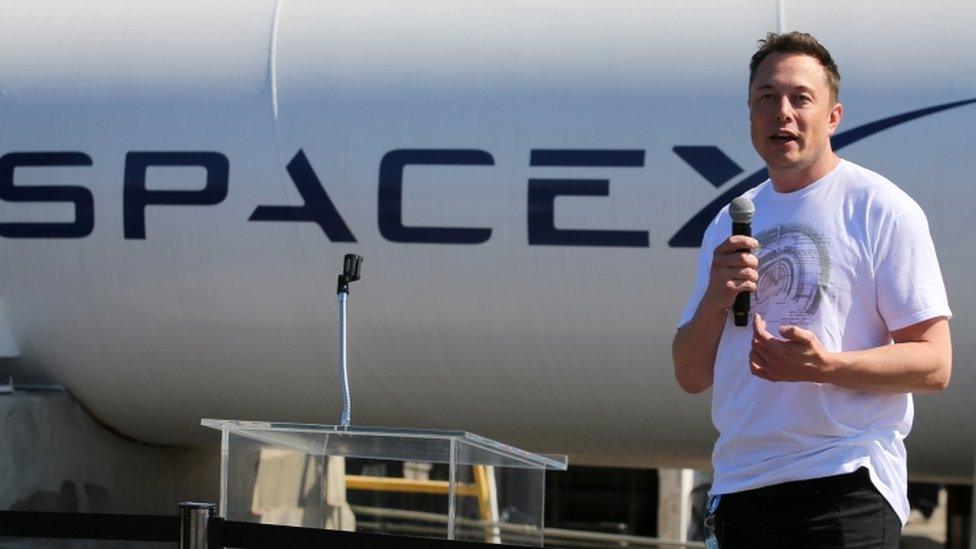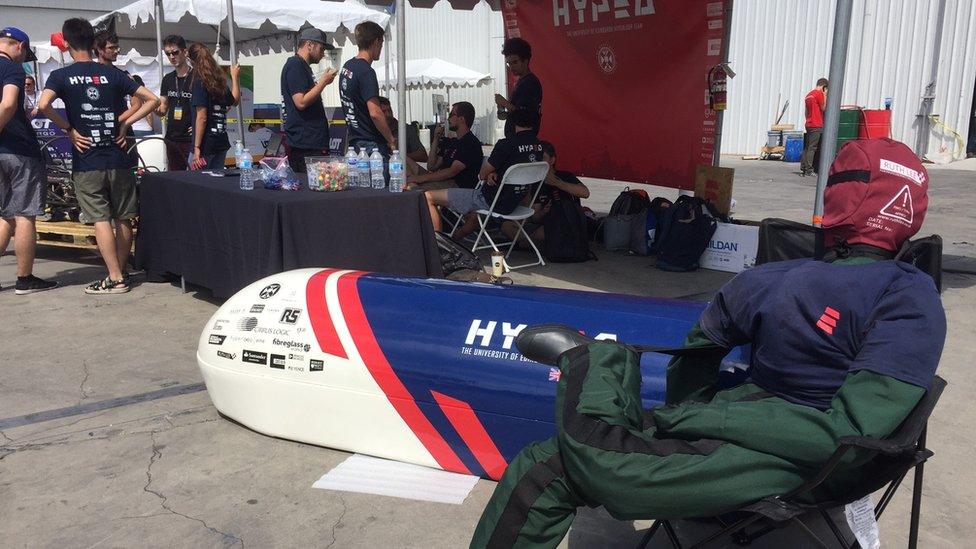Anyone for the Hyperloop? Testing high-speed pods in a vacuum tube
- Published

"Guys, this is getting awkward," billionaire Elon Musk told a group of students from Switzerland as they struggled to control their Hyperloop pod.
If all goes well, their pod would eventually travel at more than 700mph (1,120km/h), propelling people between Los Angeles and San Francisco in half an hour, instead of six hours in a car or an hour-long flight.
But this is early days and the students are testing their pod for the first time on a nearly mile-long vacuum tube track outside Mr Musk's office in Hawthorne near Los Angeles.
They'd lost connectivity. The vacuum needs to be unsealed and the pod fiddled with. Then the vacuum must be resealed and all the air inside pumped out. Revolutionising transport takes time.
The Swiss loop team eventually re-established communications with their pod and successfully completed a test on the track. Two-dozen student teams were competing - but only three qualified to test their pods in the Hyperloop tube.

The competition drew two-dozen prototypes from all over the world - including Edinburgh
None went even close to 700mph, but the winners, German's Warr team from the Technical University of Munich, blew away the competition.
"Congratulations to the Warr team," Mr Musk said as the crowd of students applauded. "That was an amazing job. That pod just went 324km/h, over 200mph."
Wheels vs levitation
Mr Musk is the entrepreneur who created Tesla electric cars and SpaceX, which has a contract with Nasa. But he doesn't just want to revolutionise the automobile and space industries.
The Hyperloop is the businessman's brainchild. He introduced the concept in 2013 and invited the world's innovators to help him make it a reality.
He hosted the competition to try to get the best possible pod prototypes. Some levitated via air - as if on an air hockey table. Others used magnets and some use wheels and don't levitate at all.
The tube is 6ft in diameter with a mobile platform for teams to get their pods in and out of the tube.
When they launch successfully, like the German Warr pod, the whizzing capsules make a surreal "whish" sound and then the crowd goes quiet until they see the speeds projected on a screen and match the increasing speeds with whoops and applause.

The vacuum hyperloop is almost a mile long
The contest was simple in one way - the fastest pod would win. The second place team was Paradigm, a North American team with members from Northeastern University in Boston and Memorial University in Newfoundland, Canada.
Another competition will be announced soon, Mr Musk told the crowd. But even if the students do succeed in getting a pod to go 700mph in the future, many are sceptical that the technology will ever become reality.
"This is an entirely unproven form of transportation," says Jack Stewart, who covers the future of transportation for Wired Magazine.
"It's a great idea. It doesn't break the laws of physics. The students here have proven that. But imagine trying to scale this up. Trying to build these tubes to fire these pods down. We can barely even build decent high-speed rail systems between major cities."
Future shock
But many underestimated Mr Musk when he said he'd reshape the way Nasa works with private companies and rockets and the way people clamour for a chance to buy the sleek, electric Tesla cars.
Manfred Schwarz, of the winning German team, said it had opted not to levitate its pod because it was focused on maximum speed in this competition.
He thinks the world's first working hyperloop with passengers is just five to 10 years away. Cargo is likely to come first if an when the systems are created, he said.
Macauley Versey, of the University of Edinburgh's Hyperloop Team, says he thinks it will become a reality - even if it sounds like science fiction at the moment.
"It's going to be very hard to do. But that's the point. It's a challenge. That's why we're all here. That's why we're trying. That's why we don't sleep. That's why we spend all this money and time and effort to do it."
Mr Musk says the Hyperloop would improve people's lives and open up the world. He spends a lot of time in traffic in Los Angeles, an experience that can even leave optimists feeling hopeless.
"It's exciting. It's inspiring for the future," he told students.
"The reason I love these things is because it makes me excited to wake up in the morning. And you need these things. There's a lot of problems in the world but if we don't have things that inspire us, what's the point of living? And that's what this is all about."
- Published16 February 2017
- Published28 March 2017